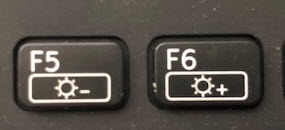Before replacing or upgrading to a larger cell battery, consider some small, yet easy changes you can make to increase the performance of the existing battery.
Quick Ways to Conserve Battery Life
Disable the wireless
If it is at all possible, temporarily disable the wireless as it will greatly increase the life of the battery. While working without wireless is not always practical, most notebooks make disabling and re-enabling wireless as quick as touching a single button. To be most efficient, group offline and online tasks so the wireless is toggled on and off minimally, which will provide more time for other uses.
Also, it can be more practical to download documents locally. This allows them to be accessed later without the need for internet access. This is especially helpful for conference presentations where wireless access is often saturated by attendees, which can cause buffering in presentations. Regardless of the promised wireless network, it is always best to be prepared for anything.
Most notebooks have a button to manage the wireless in the F keys. Newer models can have the airplane mode symbol instead of the traditional wireless icon.
An example of a button for airplane mode.
Lower the brightness
Additional quick access buttons available on notebooks are the brightness levels. Typically, the lower the ambient light, the lower the brightness will need to be on a notebook. This means if the lights surrounding you are dimmed, you can lower the notebook brightness to get more battery life while still preventing eye strain.
Another way to effectively lower the brightness without dimming the ambient lighting is to increase the brightness of document backgrounds. In brighter lighting, change the document background to white so it is easier to see. When working in lower light conditions, darken the document background to help prevent eye strain.
Typical example of brightness adjusting buttons as F keys.
Stream music from another device
It sounds obvious, but it is easy to have far more things running on a single device than we ever intended. Writing an article, doing internet research, streaming music and emailing attachments to your study group means higher resource usage, a bigger load on the CPU, more consistent fan control to cool the device and leads to a shorter battery life.
Instead, conduct research or stream music from a tablet, smartphone or even a retired device using WiFi. Any task moved to a different device helps preserve the battery life of the notebook. Additionally, dedicating a single task like streaming is a great way to extend the life of an older smartphone or tablet.
Reduce the monitor sleep delay
Reducing the time delay before the monitor goes to sleep can greatly increase the longevity of a battery. This is especially true for people who are often interrupted, referencing external resources, or multi-tasking. The display is one of the bigger power consumers, which is why notebooks with bigger screens often come with larger cell batteries by default.
To access the monitor sleep settings, search for "Power" and click on "Power & Sleep Settings" in the results. In the Power & Sleep menu, reduce the amount of inactive time the device waits before putting the monitor to sleep. The beauty of this change is that it will reduce power usage without affecting performance because it is a result of device inactivity only.
There are multiple ways to reduce the load on a notebook battery, all of which will lengthen the life of the battery. Two items that greatly impact the life of the battery are the display and wireless usage. Disabling the wireless for periods of time, lowering the brightness of the display, reducing the time delay before the monitor goes to sleep and using dedicated secondary devices for tasks such as video and audio streaming will help extend the life of the battery.
As always, multiple small changes can add up and have a big impact. Knowing what they are, and how to apply them, is key!
Enjoy this post? Subscribe to our Blog




No comments:
Post a Comment